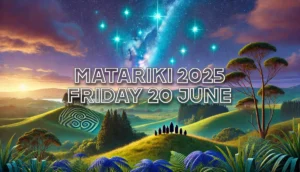Matariki and Astronomy
Understanding the Science Behind the Stars
Matariki, also known as the Pleiades, is a cluster of stars that holds great significance in Māori culture. Traditionally, the appearance of Matariki signaled the start of the Māori New Year and was a time of reflection, remembrance, and celebration. However, Matariki is not just a cultural symbol; it is also an astronomical phenomenon with fascinating scientific implications. This paper will explore the connection between Matariki and astronomy, including its composition, formation, and observable properties.
Composition of Matariki
To understand the composition of Matariki, it’s important to first understand what a star is. A star is a massive, luminous sphere of plasma held together by its own gravity. Stars are classified based on their temperature, size, and brightness. Matariki, also known as the Pleiades, is a cluster of stars that is visible in the night sky from various parts of the world, including New Zealand.
Matariki Cluster
The Matariki cluster is composed of seven stars, which are named after important Māori figures. The stars are Matariki, Pōhutukawa, Waipuna-ā-Rangi, Waitī, Tupuārangi, Tupuānuku, and Ururangi. The names of these stars have important cultural significance in Māori culture, as they represent different aspects of the natural world and are associated with different deities and ancestors.
The stars in the Matariki cluster are classified as B-type stars, which are hot, blue, and massive. B-type stars have surface temperatures between 10,000 and 30,000 Kelvin and are among the hottest stars in the universe. They are also some of the most luminous stars, meaning they emit a lot of energy. The stars in the Matariki cluster have a combined mass of around 120 times that of our sun.
440 light-years away from Earth
The stars in the Matariki cluster are approximately 440 light-years away from Earth. A light-year is the distance that light travels in one year, which is approximately 9.5 trillion kilometers. This means that the light we see from the Matariki stars tonight actually left the stars over 400 years ago, long before the first Europeans arrived in New Zealand.
Composition of Matariki
Studying the composition of Matariki can help us understand the science behind the stars and the universe as a whole. By observing the light emitted by the stars, astronomers can analyze the elements present in the stars and gain insight into how stars are formed and evolve over time. Additionally, understanding the cultural significance of Matariki in Māori culture can help foster greater appreciation and understanding of Indigenous knowledge and traditions.
Formation of Matariki
To understand the formation of Matariki, it is important to have some background on the formation of stars. Stars are formed from molecular clouds of gas and dust in space. These clouds can be hundreds of times larger than our solar system and contain elements like hydrogen, helium, and other heavier elements.
Gravity plays a significant role in the formation of stars. When a molecular cloud is disturbed by an external force, like a supernova or a nearby star, it can become unstable and start to collapse under its own gravity. As it collapses, the cloud becomes denser and hotter, eventually leading to the formation of a protostar at the center of the cloud.
Protostar
As the protostar continues to accrete mass from the surrounding cloud, it heats up and begins to emit radiation. This radiation can blow away the remaining gas and dust in the surrounding area, creating a clear space around the newly-formed star. Over time, the protostar will become a main sequence star, like our sun, and will continue to shine for millions or billions of years.
Coeval
Returning to Matariki, one theory suggests that the stars in this cluster were formed from the same molecular cloud of gas and dust, which collapsed under the force of gravity to create multiple stars simultaneously. This is known as the “coeval” theory of star formation. This theory proposes that the stars in Matariki are all roughly the same age, having formed at the same time from the same cloud.
Stars in Matariki
Another theory proposes that the stars in Matariki were formed at different times, but were gravitationally bound together to form a cluster. This theory suggests that the stars were initially formed in different parts of the molecular cloud, but their gravitational attraction to each other caused them to come together and form the cluster we see today.
Although there is still much debate about the formation of Matariki, these theories help us to better understand the complex processes that lead to the formation of stars and star clusters in our universe.
Observable Properties of Matariki
In addition to being visible with the naked eye, the stars in Matariki also have observable properties that can be studied with telescopes and other instruments. One property that has been studied is their spectra, which is the range of colors and wavelengths of light that the stars emit. By studying the spectra of the stars in Matariki, astronomers have been able to determine their chemical composition, temperature, and other physical properties.
Proper Motion
Another observable property of Matariki is their proper motion, which is the apparent motion of the stars across the sky over time. By tracking the proper motion of the stars in Matariki, astronomers have been able to determine their distance and motion relative to Earth. This information has been used to study the structure and dynamics of our galaxy, as well as the formation and evolution of star clusters.
Variable Stars
Finally, the stars in Matariki also have observable variations in their brightness, known as “variable stars.” By studying the variability of the stars in Matariki, astronomers have been able to determine their internal structure and dynamics, as well as their age and evolution. The study of variable stars in Matariki has also contributed to our understanding of the physical processes that occur in massive stars, such as nuclear fusion and stellar explosions.
Cultural Significance of Matariki
The cultural significance of Matariki for Māori people cannot be overstated. Matariki holds a special place in Māori cosmology and is deeply intertwined with Māori culture, values, and practices. It is a time for reflection, renewal, and celebration.
Pay Respects to Ancestors
For many Māori people, Matariki is viewed as a time of remembrance, to acknowledge and pay respects to their ancestors. It is also a time to celebrate new beginnings, as it marks the start of a new year in the Māori lunar calendar. During Matariki, Māori people traditionally welcomed new life, celebrated the harvest season, and prayed for good health and prosperity in the coming year.
Interconnectedness between the Land, the Sea, and the Stars
Matariki also has strong associations with the environment and the natural world. Māori people have long recognized the interconnectedness between the land, the sea, and the stars. The appearance of Matariki signaled the beginning of the winter solstice, which was a time of rest and rejuvenation for the land. Matariki also provided important environmental cues for planting, fishing, and hunting.
Shaping Māori Identity and Culture
In addition to its practical and spiritual significance, Matariki has played an important role in shaping Māori identity and culture. The celebration of Matariki has been revitalized in recent years, as Māori people have sought to reclaim their cultural traditions and practices. Matariki celebrations now include a wide range of activities, from cultural festivals to community feasts, and from art exhibitions to storytelling events.
Overall, the cultural significance of Matariki reflects the deep connection between Māori people, the environment, and the cosmos. Matariki is a time to honor the past, celebrate the present, and plan for the future. It is a time to recognize the interdependence between human beings and the natural world, and to reaffirm the importance of cultural heritage and identity.
Matariki is a fascinating astronomical phenomenon with both scientific and cultural significance. Understanding the science behind the stars can deepen our appreciation for their beauty and complexity, while also connecting us to the cultural traditions and practices that have been passed down for generations. As we celebrate Matariki, let us take time to reflect on the wonders of the universe and the rich history and traditions of Māori culture.


